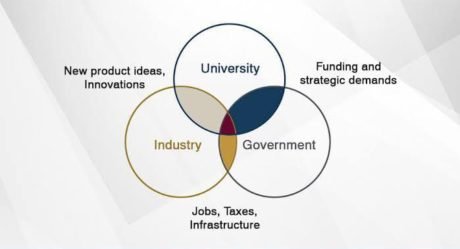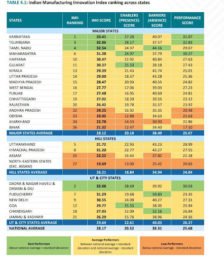Context- A survey on the degree of innovation among manufacturing firms found that Karnataka, overall, is the most “innovative” state.
– Survey conducted by the Department of Science and Technology (DST) in collaboration with the United Nations Industrial Development Organization
(UNIDO) and is part of the National Manufacturing Innovation Survey (NMIS) 2021-22.
– In overall Dadra Nager Haveli and Daman Diu, Telangana and Tamil Nadu are placed at 2nd,3rd and 4th respectively.
– Low-scoring states are North-eastern states (excluding Assam) followed by Bihar, Assam, Jharkhand
– Telangana, Karnataka and Tamil Nadu had the highest share of innovative firms at 46.18%, 39.1% and 31.9%, respectively, with Odisha, Bihar and
Jharkhand reporting the lowest share of such firms at 12.78%, 13.47% and 13.71 respectively.
– DST’s first national innovation survey was held in 2011.
– India’s manufacturing sector contributes to 16-17% of India’s GDP (the target is 25%)
About NMIS-
– NMIS 2021-22 is an independent assessment of the innovation performance of manufacturing firms and sectors in India to inform and support policy
for improving the productivity and competitiveness of manufacturing farms and the study is not to assess the effectiveness of specific policies.
– Aim- Evaluate the innovative performance of manufacturing firms in India.
– Components- NMIS survey 2021-22 had two specific components-
1. Firm-level survey- To empirically measure the innovation performance of the manufacturing sector (product innovation, manufacturing
innovation, business process innovation, innovation input activities, source of information and resources, impact id digitalisation,
infrastructure, factors affecting innovative activities).
2. Sectoral system of innovation (SSI) survey-To find innovation barriers and opportunities to enhance system actors, the role and impact of
actors and institutions on innovative activities, impact of policy instruments (fiscal, monetary, regulatory etc).
– Survey conducted in selected five key manufacturing sectors such as textile, food & beverage, automobile, pharma, and ICT (information and communication technology.
– Key finding – triple helix type of model– model focuses on the relationship between universities and knowledge-based institutions (KBIs), firms, government and hybrid organisations.

Barrier to innovation-
1. Lack of funds within the firms or groups.
2. Claiming the high innovation cost
3. Lack of external sources of finance.
4. Low demand for innovation in the market.
5. Lack of understanding of technologies.
6. Lack of legal framework.
7. Lack of clear national innovation strategies.
Recommendations
1. Adopting a system innovation approach policy should be based on the needs of the actors in the system.
2. Policy should be a demand-driven perspective, with the inclusion of civil societies and emphasis on the triple helix model (- bridging the
knowledge gap and better coordination among them).
3. Promote a commitment to and ownership of a development agenda.
4. Consolidating of existing database and integration of feedback mechanism for improvements.
5. Encourage capitalists to innovative start-ups by providing by tax incentives and redress the barriers.






